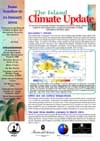An overview of the present climate in the tropical South Pacific Islands, with an outlook for the coming months, to assist in dissemination of climate information in the Pacific region.
Number 16 – 10 January 2002
December's Climate: The South Pacific Convergence Zone was very active bringing high rainfall to many islands from north of Papua-New Guinea, east through Nauru, Western Kiribati, Tuvalu and Tokelau, and southeast to the Northern Cook Islands and much of French Polynesia. Rainfall was also high over Samoa, northern Tonga, and the North Island of New Zealand. In contrast, well below average rainfall occurred along the Queensland coast of Australia and across the Coral Sea to New Caledonia and Vanuatu. Rainfall was also well below average in the Kermadec’s and Southern Cook Islands. Three tropical cyclones, Trina, Vicky, and Waka (the most severe), occurred in the region during the month.
ENSO and sea surface temperatures (SST): The Southern Oscillation Index (SOI) has been quite variable in recent months, but the 3-month mean of -0.3 is still in the neutral range. Trade winds were slightly enhanced in the central Equatorial Pacific, with westerly anomalies in the west. A warmer west – cooler east temperature gradient persists across the Southwest Pacific, but equatorial Sea Surface Temperature (SST) anomalies are weak. Five of the twelve global SST forecast models show indications of a possible evolution towards weak warm ENSO conditions in the months just following the Southern Hemisphere wet season.
Forecast validation: How well are we doing with our predictions?
Three month outlook: The SPCZ is expected to be more active than usual with average to above average rainfall in western equatorial latitudes from Western Kiribati southeast to Tonga and Niue, including Tuvalu, Wallis and Futuna, and Samoa. Average to below average rainfalls are likely in the equatorial east, including the Society, Marquesas, and Southern Cook islands, and from northern Queensland across to Vanuatu.
Feature Article: Three tropical cyclones so far.
Sources of South Pacific rainfall data

A complete copy of The Island Climate Update is available as an Adobe Acrobat PDF file. This does not contain any extra information over that obtained by clicking on the individual items above.
To view the PDF file, you'll need Adobe Acrobat Reader, which you can download free from Adobe.
